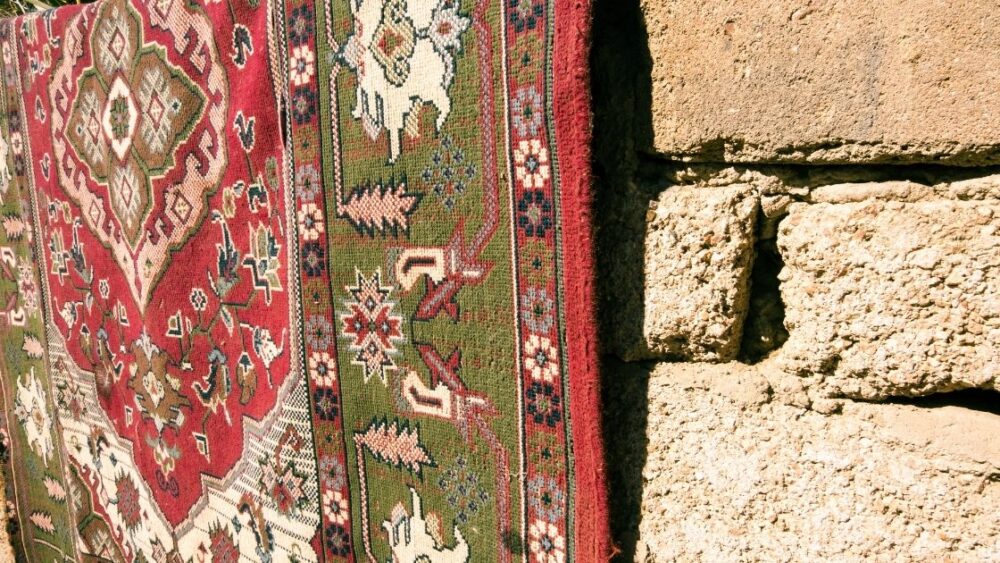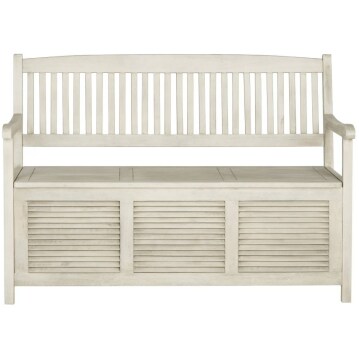
If you’re trying to create an outdoor space with an inviting and defined aesthetic, an outdoor rug is the easiest way. Just like any indoor rug, an outdoor rug pulls together the seating area to create a welcoming atmosphere. But, what about the elements? Can you leave your outdoor rug out in the rain? Not all rugs are created equal, which is why we’re going to take a look at 5 types of patio rugs that can withstand anything from a light sprinkle to a full-blown thunderstorm.
What Types of Rugs are Suitabe for Rain?

In the following below, we will discuss the five different types of rugs that are suitable for any elements. Although any rug can be left outdoors, many are damaged because of improper use. So it’s always a good idea to also look at which material is used before purchase because some may say for outdoor use, but don’t specify weather tolerance.
For more information on outdoor rugs, check out this article: Are Outdoor Rugs a Good Idea? Here’s The Deal. Also, you can check out our affiliate outdoor rug category here: Rugs
Browse our Affiliate Products
Polypropylene
Polypropylene takes the cake as one of the most commonly used thermoplastics globally.This material is incredibly universal as it’s found in everything from sour cream containers, to grocery bags, to kids’ toys.
While it’s ‘plastic’ it’s probably not what you’re thinking of. Polypropylene (often called ‘olefin) is made up of synthetic fibers, and when used for an outdoor rug is incredibly lightweight, soft, and easy to clean – even with bleach.
It’s incredibly strong which is ideal for rugs that bear high volumes of foot traffic, as well as climates where the weather changes often. Polypropylene rugs are incredibly stain resistant, an ideal patio rug for families with young children that may spill often.
In addition, it doesn’t retain liquid, so it won’t grow mildew or mold on the chance it gets wet. When exposed to the elements, particularly the hot sun, polypropylene won’t fade, making it one of the most used materials for patio rugs on the market.
You’ll be able to tell if a rug is made of polypropylene by feeling the texture. If it feels scratchy and stiff, it’s most likely polypropylene.
Some examples of polypropylene rugs are:
- Wayfair.com: Kitts Floral Indoor / Outdoor Area Rug in Green
- Wayfair.com: Alegre Indoor / Outdoor Area Rug in Tan
- Rugsusa.com: Blue Honeycomb Labyrinth Area Rug
- Rugs.com: 5′ x 8′ Outdoor Lattice Rug
- Amazon.com: Unique Loom Collection Casual Transitional Solid Heathered Indoor/Outdoor Flatweave Area Rug, 4 ft x 6 ft, Light Gray/Gray
If you want more information on doormats, check out this article: Tips for Choosing the Best Outdoor Doormats for Your Needs
Eco-Friendly Polyethylene Terephthalate (P.E.T)
PET is a form of synthetic polyester made from recycled plastics, usually bottles. Not only are PET rugs great for the planet, they’re durable – while still remaining soft – and can often be reversible.
Due to their remarkably strong durability, PET rugs are ideal for anyone with high foot traffic, such as families with young kids, or anyone with multiple pets. If you’re looking to add an organic touch to the outdoor space in your backyard, PET patio rugs are an excellent option.
In addition to durability, eco-friendliness, and a soft texture, PET rugs are very easy to clean. If your rug isn’t at the top of your priority list, have no fear – the fibers in PET shag rugs will draw dirt in like a magnet until you have time to shake it out.
While PET rugs are able to withstand rain, it’s possible for them to retain leftover moisture, so it’s recommended to hang dry after a shower.
Some examples of Polyethylene Terephthalate (P.E.T) rugs are:
- Amazon.com: Gertmenian Tropical Collection Outdoor Rug Patio Area Carpet 8×10 Large Red Stripes
- Wayfair.com: Weon Floral Indoor / Outdoor Area Rug in Gray/Beige
- Bedbathandbeyond.com: Tayse Rugs Denver Dickens 5’3 x 7’3 Indoor/Outdoor Area Rug in Taupe
Polyester
Maybe you live in Nevada, where you only get 9 inches of rain a year. However, when that rain does come you want to be prepared. This is where polyester comes in.
Polyester can withstand a mild to moderate amount of rain and is astonishingly tough when it comes to resisting the elements. Patio rugs made of polyester are known to be long-lasting with minimal fade over time. While polyester fabric repels stains, it has a harder time with oil-based spills, so it’s not recommended for use underneath an outdoor dining table.
If you care for your polyester outdoor rug properly, it can last anywhere from 5 to 15 years!
Some examples of polyester outdoor rugs are:
- Jcpenny.com: nuLoom Hand Tufted Palm Springs Rug
Nylon
Known for their strength and flexibility, nylon outdoor rugs are perfect for anyone looking for an easy to clean, yet long-lasting piece of patio decor.
While nylon rugs are incredibly resistant to anything from a light shower, hail, snow, or hot and humid temperatures, it’s recommended to avoid leaving it in the hot sun – as it can absorb heat and burn the bottoms of your feet if you’re not careful.
Due to the risk of it overheating, nylon patio rugs are ideally suited for covered patios, where direct sunlight isn’t penetrating it for hours.
Some examples of nylon rugs are:
- Wayfair.com: Covey Moroccan Indoor / Outdoor Area Rug in Grey
- Kohls.com: Mohawk® Home Alexa Medallion Indoor Outdoor Accent Area Rug
- Rugstudio: Oriental Weavers Arabella 15927 Ivory-Multi Area Rug
Blended Materials
If it’s too difficult to choose, you always have the option to purchase a rug made of more than one material.
For example, you can buy a nylon rug woven together with olefin polypropylene.
This gives you an extra layer of protection against weather, foot traffic, and normal wear and tear over the years. This is ideal for those living in aggressive climates.
Blends like 85% polyester / 15% propylene are more affordable than ‘purebred’ nylon or PET rugs, but give you all the added benefits both materials bring to the table.
Click to here to view our other affiliate selection of: Indoor/Outdoor Area Rugs
What Happens If My Outdoor Rug Gets Wet?
If your outdoor rug gets wet, there’s nothing to worry about.
Outdoor patio rugs are specifically designed to withstand the elements but specifically rain – since every climate deals with it.
However, this being said, if you’re going through a particularly rainy season, it’s advised to bring your rug inside, as outdoor rugs still can moldy if not given proper time to dry all the way through.
If your rug is taking quite some time to dry off, hang drying it in the sun is a good way to guide the process along faster. Just remember, if it’s made of nylon don’t touch it with your bare hands after it’s done drying or you’ll regret it quickly.
How Do I Care For My Outdoor Rug After It Gets Wet?

Outdoor rugs should be maintained weekly to ensure dirt buildup isn’t sticking to the fibers. Vacuuming is a common way most people take care of any residue left behind from muddy shoes.
After it gets wet, it’s recommended to air dry it for at least 24 hours in the sun to ensure your rug has been dried through and through. If you decide to leave your rug in the sun where it is, remember to flip it over after a few hours to allow the backside to dry, and avoid mold growing on your deck.
So, Can Outdoor Rugs Be Left Out In The Rain?
Not every single type of rug is able to withstand a large amount of condensation, however, if you purchase a rug made of polypropylene, recycled PET, polyester, nylon, or any blend of these four, your rug will remain strong, durable, and last for years.
If your rug gets unbearably wet, hang dry it in direct sunlight to ensure all moisture is gone. If hang drying isn’t an option, make sure you’re flipping your rug over multiple times throughout the drying process, otherwise, you may be dealing with more than just a wet rug.













